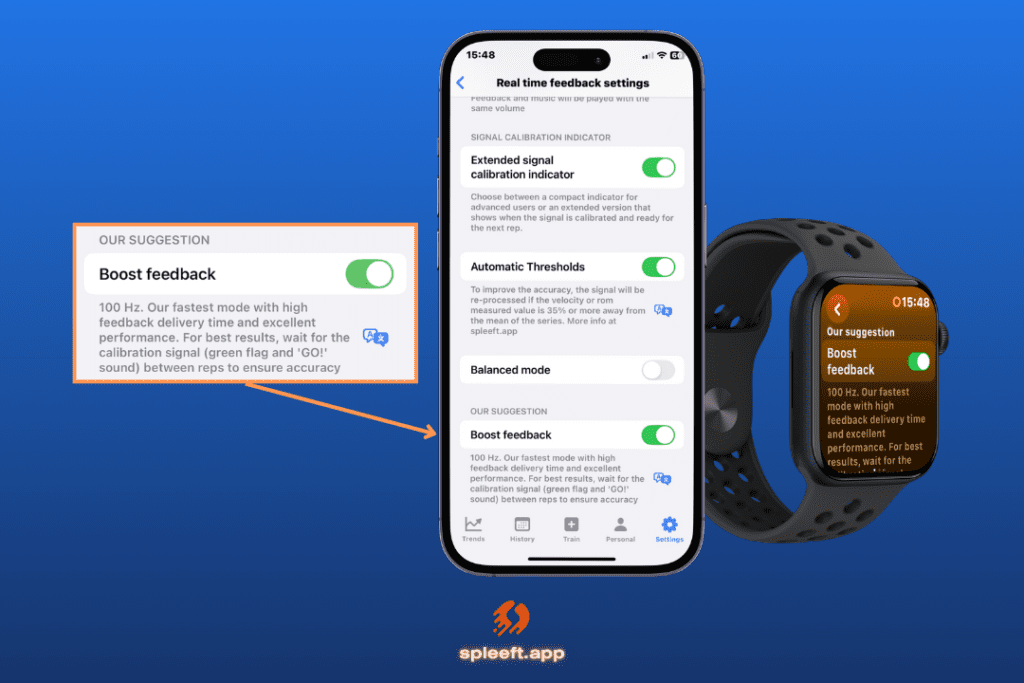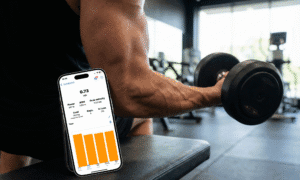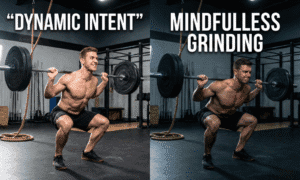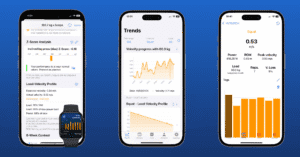Abbiamo ottimizzato i nostri algoritmi per adattarli alla velocità di qualsiasi dispositivo VBT leader del settore. Ora, il feedback sulla velocità viene fornito immediatamente dopo aver completato ogni ripetizione.
SCARICA ORA L'APP SPLEEFT PER iOS, ANDROID E APPLE WATCH!
Attiva subito la modalità Boost
Di default, la modalità Boost è abilitata sia su Apple Watch che su iPhone. Se non è attiva, puoi attivarla nelle impostazioni di Spleeft sul tuo Apple Watch. Per le misurazioni basate su iPhone, vai a Impostazioni > Impostazioni feedback in tempo reale.
Una volta abilitato, noterai un feedback significativamente più rapido dopo ogni ripetizione. Tuttavia, per garantire affidabilità della misura, dovresti rimanere immobile per un attimo per consentire la calibrazione del punto zero, proprio come prima. Sull'Apple Watch, sentirai una vibrazione al termine della calibrazione. Sull'iPhone, vedrai un segnale visivo: un messaggio che passa da verde ad arancione. Inoltre, assicurati che il volume del tuo iPhone sia attivato: Spleeft dirà "Vai!" per segnalare che la calibrazione è terminata e che sei pronto per la ripetizione successiva.
Anche l'algoritmo di rilevamento della fase stazionaria utilizzato per la calibrazione è stato ottimizzato per la massima velocità.
Non hai tempo da aspettare? Nessun problema
Sebbene brevi pause tra le ripetizioni siano utili per le prestazioni, comprendiamo che alcuni contesti di allenamento non lo consentono. Spleeft controlla costantemente ogni fase stazionaria rilevata per garantire che tutte le ripetizioni precedenti vengano registrate e convalidate. Se si salta la pausa di calibrazione, potrebbe verificarsi un errore accumulato. In questi casi, Spleeft darà priorità e memorizzerà i dati più affidabili disponibili.
Se riscontri problemi con la nuova modalità, puoi sempre tornare alla modalità Bilanciata, che utilizza l'algoritmo precedente. Come sempre, apprezziamo il feedback degli utenti per continuare a migliorare.
Miglioramenti aggiuntivi
Abbiamo introdotto ulteriori ottimizzazioni specifiche per specifici tipi di esercizi, inclusi esercizi basati su macchinari come lat pull down e leg extension. Come forse saprete, posizionando l'iPhone sul pacco pesi in movimento verticale è possibile misurare la velocità per quasi tutti gli esercizi. Stiamo inoltre continuando a migliorare il supporto per i sollevamenti olimpici.
Grazie al vostro feedback, abbiamo implementato ulteriori miglioramenti nella nuova modalità Coach.
Qual è stata la sfida?
Fino ad ora i nostri algoritmi erano già quasi accurato come uno dei dispositivi VBT più convalidati disponibile. Le misurazioni della velocità ottenute tramite Apple Watch sono già state sottoposte convalida indipendentee presto arriverà un nuovo studio che confermerà ulteriormente i nostri dati.
Tuttavia, per garantire la precisione, l'utente doveva rimanere completamente immobile tra una ripetizione e l'altra per calibrare il segnale. Questo produceva risultati altamente affidabili, ma nella pratica, soprattutto in palestra, le vibrazioni del bilanciere o le ripetizioni continue spesso ritardavano il feedback e compromettevano l'esperienza dell'utente.
Con il nuovo aggiornamento, abbiamo mantenuto questa precisione, fornendo al contempo un feedback sulla velocità subito dopo la fase concentrica. Di conseguenza, Spleeft offre un'esperienza in palestra molto più fluida ed efficiente.
Comprendere i limiti dell'accelerometro e la nostra soluzione
Di seguito è riportato un grafico che illustra diverse ripetizioni di squat. Dopo la prima ripetizione, si verifica una lunga pausa per la calibrazione del segnale. Successivamente, vengono eseguite tre ripetizioni consecutive senza pause. Come si vede nel grafico, un errore, noto come deriva, si accumula gradualmente quando non c'è un punto di riferimento, come una fase stazionaria. Questa deriva deriva principalmente dagli errori intrinseci nell'integrazione matematica e nelle variazioni di orientamento del sensore.
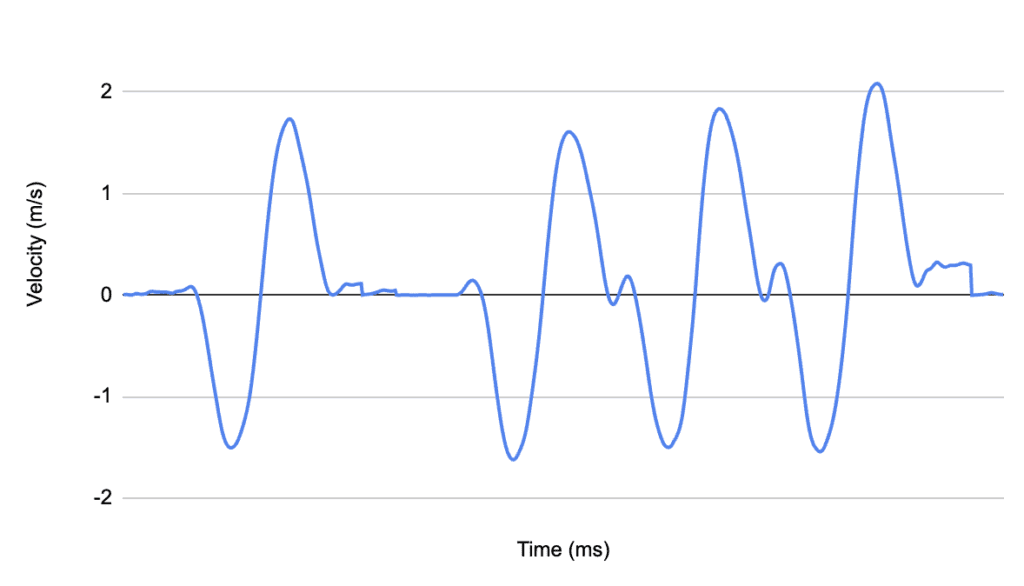
Tuttavia, la nostra ultima ricerca (condotta poco prima di questo aggiornamento) mostra che, per una singola ripetizione, questa deriva non è abbastanza significativa da influire sull'affidabilità della velocità media. Anzi, eliminando il requisito di ricalibrazione si elimina una delle principali fonti di errore: le vibrazioni della barra causate da movimenti esplosivi.
Pertanto, il metodo più affidabile rimane l'esecuzione di una ripetizione seguita da una breve pausa per la ricalibrazione, al fine di evitare l'accumulo di errori. Il vantaggio ora è che i dati sulla velocità sono disponibili immediatamente, dando il tempo di interpretarli ed elaborarli – se hanno soddisfatto le aspettative, se si è verificata una perdita di velocità, ecc. – anche mentre il sistema si calibra in background.
Presto pubblicheremo un articolo più dettagliato che spiegherà la ricerca alla base di questo aggiornamento. Inoltre, le nostre ultime scoperte saranno applicate a altezza del salto misurazioni, che coprono CMJ, SJ, DJ e modalità di precisione.
Iván de Lucas Rogero
Prestazioni fisiche MSC e CEO SpleeftApp
Dedicato al miglioramento delle prestazioni atletiche e dell'allenamento ciclistico, unendo scienza e tecnologia per ottenere risultati.

